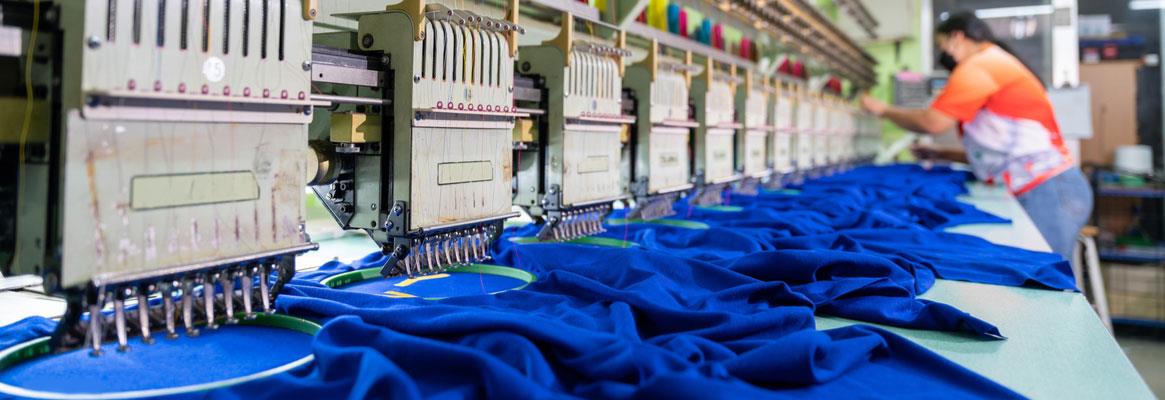Vijayalaxmi, along with a few dozen of her co-workers, watch apprehensively as hundreds of newly procured German-made machines are set up to make the production process faster at the knitwear unit of an export house based in India’s knitwear hub of Tiruppur. These machines need minimal human interventions except for programming and occasional cleaning. After spending more than a decade in the company, the workers have been given a month’s notice to look for new jobs. Vijayalaxmi and her co-workers will find their livelihood in some other knitting unit till technology and automation catches up with that company as well.
Technology and automation have been a threat to workers across all sectors. Unlike the electronics and automobile industries, the apparel sector had some extent of protection. Fabrics and apparel production processes require special attention and detailing that once was only possible through human hands. But in the last decade, more and more garment manufacturing units are moving towards automation. According to a study, robotics can reduce the labour force by 80 per cent (Vashisht and Rani, 2020). Raymond employed about 30,000 workers in 2016. However, they replaced about 10,000 workers using robots and technology in the next three years. Sanjay Behl, CEO of Raymond, said in an interview in the Economic Times, “Roughly 2,000 (people) work in each plant. Through technological intervention, we are looking to scale down the number of jobs to 20,000 through multiple initiatives in technology. One robot could replace around 100 workers. While it is happening in China at present, it will also happen in India.” (Economic Times, 2016).
One of the three pillars of sustainability is social equity. The sustainable development goals target decent work and economic growth for all. The intra-generational equity is also important along with intergenerational equity. However, most natural, social and environmental scientists advocate that ‘sustainable development’ is an oxymoron (SACHS, 2015). This logic makes sense with even the inexpensive workforce of the developing countries falling prey to automation. With the global inflation rates, the labour costs are also increasing, and advanced technology is making machines that can handle even the difficult tasks.
Bangladesh is a live example of this issue. According to an estimate, there should be approximately 2 million new jobs every year with the growing apparel market. However, only 60,000 new jobs are added annually. In the meantime, the apparel production in Bangladesh keeps growing at a rate of 19.5 per cent using automation. Zahid Hussain, a lead economist in the South Asia Finance and Poverty group of the World Bank, says, “If you cannot absorb [young people] in productive activities, they will do something. And the something they will do may not be socially pleasant. It’s a social time bomb.”
The main purpose that brought industrialisation to India and other developing countries was to alleviate poverty (Mishra, 1978). A number of policies were made to help set up industries with the target of growth in national income, reduction of income inequalities, and providing employment with amenities of health and education. The lenient environmental policies of these developing nations helped a number of companies establish their businesses. But at least the cost of damage to the environment was rewarded with employment and livelihood generation. With more and more people losing jobs, it seems that the main purpose of these industrialised nations is lost.
The apparel manufacturing companies often invest in automation to speed up the production process. The faster production lead times help deliver orders faster. The reduction in labour costs additionally makes the end product cheaper. These two factors combined together pave the way for fast fashion apparel. The garments thus produced will be used, consumed and discarded faster. With ample cheap options, consumers will buy more, and an emotional connection with these products will be a rare case. That brings the question of whether the aim of these businesses is to create a faster supply chain for both production and consumption.
But does that mean discarding technology and automation altogether? Not at all. It is essential to achieve the right balance. Technology that is targeted to reduce waste, increase detailing and standardise processes without compromising the employability factors is important. The recycling process of garments begins with sorting according to material and colour. Human hand and feel are often not enough to segregate these according to the material. Intervention of technologies like NIR (near-infrared) is required to sort garments made with blended fabrics. Virtual 3D modelling and sampling reduce the sampling cost and time to a great extent. Additionally, the initial samples are often not sold and are discarded into landfills eventually. Virtual sampling also reduces the waste thus generated. Examples of such technological interventions are ample. At the same time, it is noteworthy that automation creates scope for a different set of employment. Software developers, coders, etc will have those jobs. However, in developing countries like India, the diverse society is comprised of different education levels and skill levels. Hence, this society also needs jobs for different segments to make inclusive economic growth.
Inclusive growth indicates economic growth that will create employment opportunities for all and will help in the reduction of poverty by empowering people through education and skill development. The world is moving towards an era of Industrial Revolution 4.0. However, these advancing technologies have the capabilities of either increasing or decreasing social inequality depending on the way it is used. It is unfortunate that the Indian apparel industry workforce, who were once called karigars, today struggle for livelihood. Through innovative partnerships among organisations, NGOs and government bodies, sustainable development for an equal society may be achieved. Inclusive growth will help empower the vulnerable and marginalised population, improve livelihoods and eventually attain equality.
Predicting future technology and its job implication in the future is tough. However, it is true that in a labour-intensive country like India, aggressive automation may invite huge unwanted social costs. We need to explore huge opportunities to look at small, low-cost devices that assist the worker in doing part of the job and thus increase the output of the existing workforce. Recent publications from ILO in the Indian apparel industry also back this idea (Bárcia De Mattos et al., 2021). Sometimes automation invites financial burden for small- and medium-size Indian apparel firms if it is not used with financial and technological prudence. At the same time, high-end customised products generated from very sophisticated automatic processes can create competencies for the industry to get rid of the price war that hurts profitability. The personalised high-end apparel market has been expanding globally. It invites automation and artisanship as well. India, a country of artisans and huge traditional knowledge, has the possibility of building an artisanal economy to cater to the global demand for bespoke products and products with elegant craftsmanship. A wide range of automation technologies is potentially available for facilitating and empowering this artisanal economy. (Eglash, R. 2020) Probably the Indian apparel industry has to find the right mix which suits the country’s requirements.
The authors hope that this article will invite and facilitate a discussion on a future vision for a more inclusive Indian apparel industry in which economic value, human labour value, ecological value and social value can synergise without the fear of extraction, exploitation or alienation.









Comments